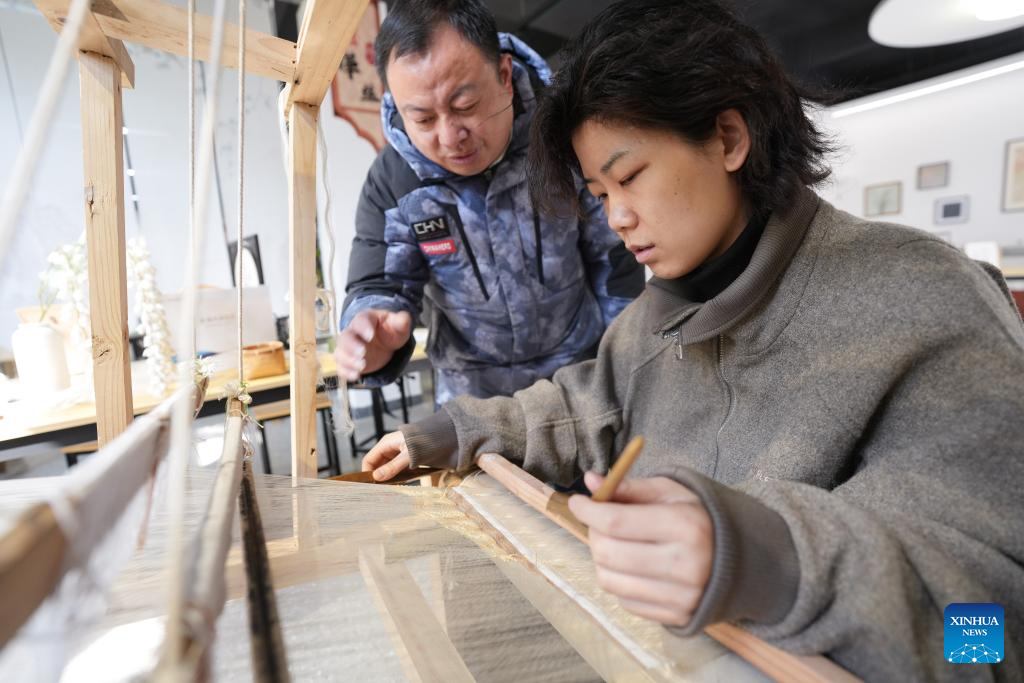
Ke Xiangxiang (L) introduces Kesi weaving technique to a college student from Xi'an, northwest China's Shaanxi Province, at a silk art exhibition hall transformed from a silkworm farm in Moganshan Town of Deqing County, Huzhou City, east China's Zhejiang Province, Feb. 19, 2025. Kesi, one of traditional Chinese silk tapestries, is created by unique silk-weaving method with distinct warp and weft technique.
Ke Xiangxiang is an inheritor of the Kesi weaving technique in Deqing County. He started learning the technique after entering Deqing County arts and crafts factory in 1993. With the revival of the traditional culture, he set up his own intangible cultural heritage studio in 2018. While adhering to the tradition, he has been trying to promote the development of the Kesi weaving technique through innovation. He uses special water ripple patterns to make silk products, such as table cloth, bags, fans and even jewelry, that are more in line with contemporary aesthetics. (Xinhua/Weng Xinyang)
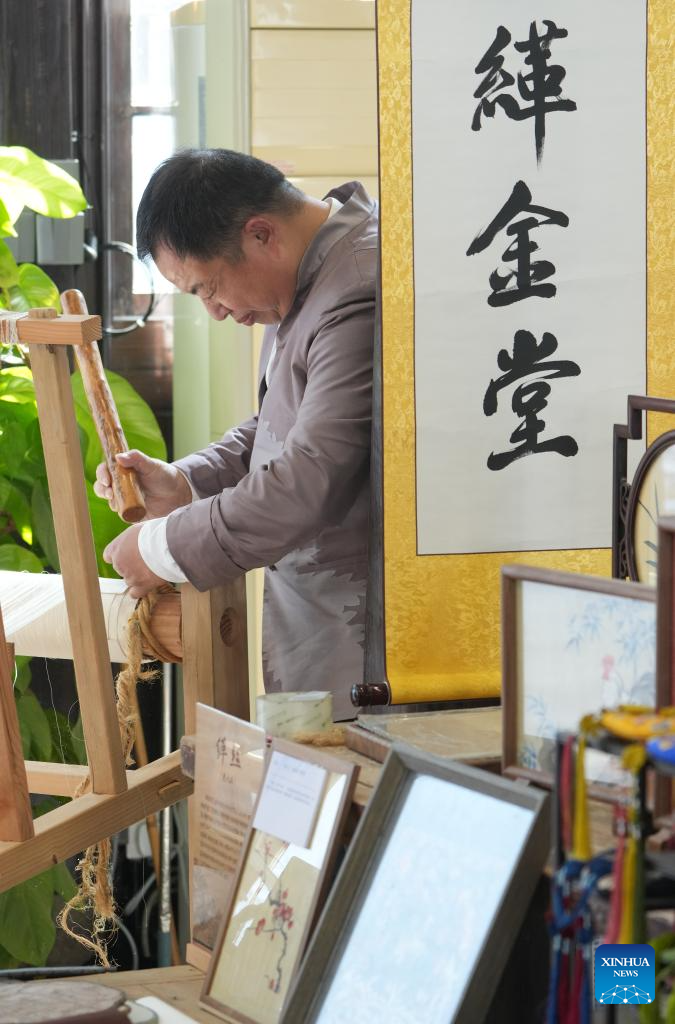
Ke Xiangxiang adjusts a weaving tool at his studio in Qianyuan Town of Deqing County, Huzhou City, east China's Zhejiang Province, Feb. 19, 2025. Kesi, one of traditional Chinese silk tapestries, is created by unique silk-weaving method with distinct warp and weft technique.
Ke Xiangxiang is an inheritor of the Kesi weaving technique in Deqing County. He started learning the technique after entering Deqing County arts and crafts factory in 1993. With the revival of the traditional culture, he set up his own intangible cultural heritage studio in 2018. While adhering to the tradition, he has been trying to promote the development of the Kesi weaving technique through innovation. He uses special water ripple patterns to make silk products, such as table cloth, bags, fans and even jewelry, that are more in line with contemporary aesthetics. (Xinhua/Weng Xinyang)
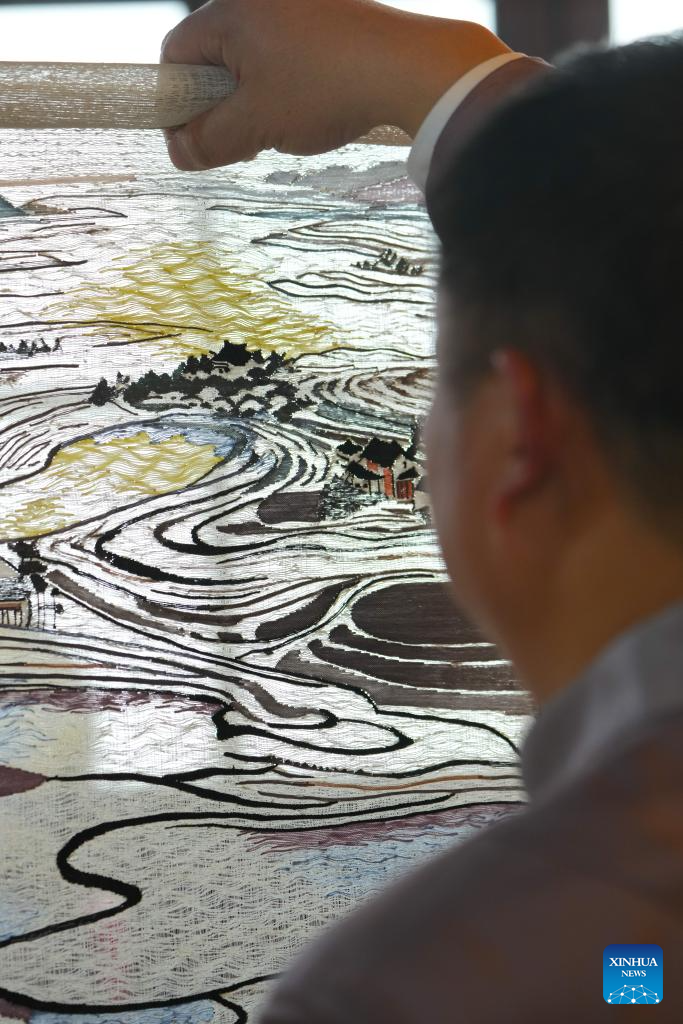
Ke Xiangxiang shows a piece of Kesi work created with water ripple patterns at his studio in Qianyuan Town of Deqing County, Huzhou City, east China's Zhejiang Province, Feb. 19, 2025. Kesi, one of traditional Chinese silk tapestries, is created by unique silk-weaving method with distinct warp and weft technique.
Ke Xiangxiang is an inheritor of the Kesi weaving technique in Deqing County. He started learning the technique after entering Deqing County arts and crafts factory in 1993. With the revival of the traditional culture, he set up his own intangible cultural heritage studio in 2018. While adhering to the tradition, he has been trying to promote the development of the Kesi weaving technique through innovation. He uses special water ripple patterns to make silk products, such as table cloth, bags, fans and even jewelry, that are more in line with contemporary aesthetics. (Xinhua/Weng Xinyang)
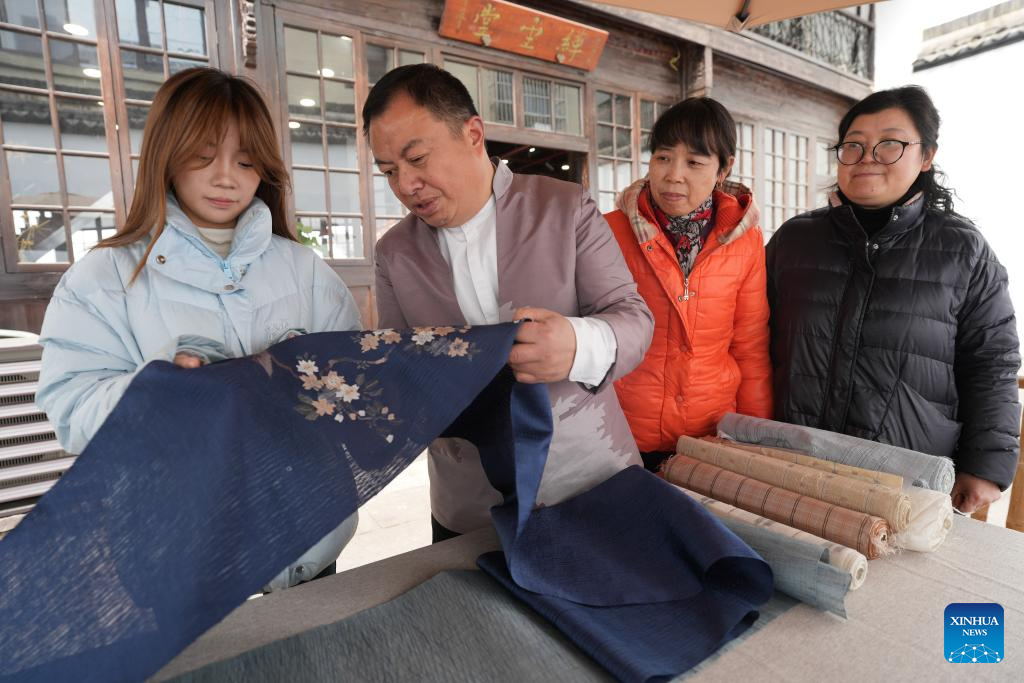
Ke Xiangxiang (2nd L) shows a piece of old Kesi work he collected to the staff members of his studio in Qianyuan Town of Deqing County, Huzhou City, east China's Zhejiang Province, Feb. 19, 2025. Kesi, one of traditional Chinese silk tapestries, is created by unique silk-weaving method with distinct warp and weft technique.
Ke Xiangxiang is an inheritor of the Kesi weaving technique in Deqing County. He started learning the technique after entering Deqing County arts and crafts factory in 1993. With the revival of the traditional culture, he set up his own intangible cultural heritage studio in 2018. While adhering to the tradition, he has been trying to promote the development of the Kesi weaving technique through innovation. He uses special water ripple patterns to make silk products, such as table cloth, bags, fans and even jewelry, that are more in line with contemporary aesthetics. (Xinhua/Weng Xinyang)

A craftswoman makes a piece of Kesi work with water ripple patterns at Ke Xiangxiang's studio in Qianyuan Town of Deqing County, Huzhou City, east China's Zhejiang Province, Feb. 19, 2025. Kesi, one of traditional Chinese silk tapestries, is created by unique silk-weaving method with distinct warp and weft technique.
Ke Xiangxiang is an inheritor of the Kesi weaving technique in Deqing County. He started learning the technique after entering Deqing County arts and crafts factory in 1993. With the revival of the traditional culture, he set up his own intangible cultural heritage studio in 2018. While adhering to the tradition, he has been trying to promote the development of the Kesi weaving technique through innovation. He uses special water ripple patterns to make silk products, such as table cloth, bags, fans and even jewelry, that are more in line with contemporary aesthetics. (Xinhua/Weng Xinyang)

A college student tries to make a piece of Kesi work with water ripple patterns at a silk art exhibition hall transformed from a silkworm farm in Moganshan Town of Deqing County, Huzhou City, east China's Zhejiang Province, Feb. 19, 2025. Kesi, one of traditional Chinese silk tapestries, is created by unique silk-weaving method with distinct warp and weft technique.
Ke Xiangxiang is an inheritor of the Kesi weaving technique in Deqing County. He started learning the technique after entering Deqing County arts and crafts factory in 1993. With the revival of the traditional culture, he set up his own intangible cultural heritage studio in 2018. While adhering to the tradition, he has been trying to promote the development of the Kesi weaving technique through innovation. He uses special water ripple patterns to make silk products, such as table cloth, bags, fans and even jewelry, that are more in line with contemporary aesthetics. (Xinhua/Weng Xinyang)

Ke Xiangxiang (1st R) introduces cultural and creative products made with Kesi weaving technique to visitors at a silk art exhibition hall transformed from a silkworm farm in Moganshan Town of Deqing County, Huzhou City, east China's Zhejiang Province, Feb. 19, 2025. Kesi, one of traditional Chinese silk tapestries, is created by unique silk-weaving method with distinct warp and weft technique.
Ke Xiangxiang is an inheritor of the Kesi weaving technique in Deqing County. He started learning the technique after entering Deqing County arts and crafts factory in 1993. With the revival of the traditional culture, he set up his own intangible cultural heritage studio in 2018. While adhering to the tradition, he has been trying to promote the development of the Kesi weaving technique through innovation. He uses special water ripple patterns to make silk products, such as table cloth, bags, fans and even jewelry, that are more in line with contemporary aesthetics. (Xinhua/Weng Xinyang)
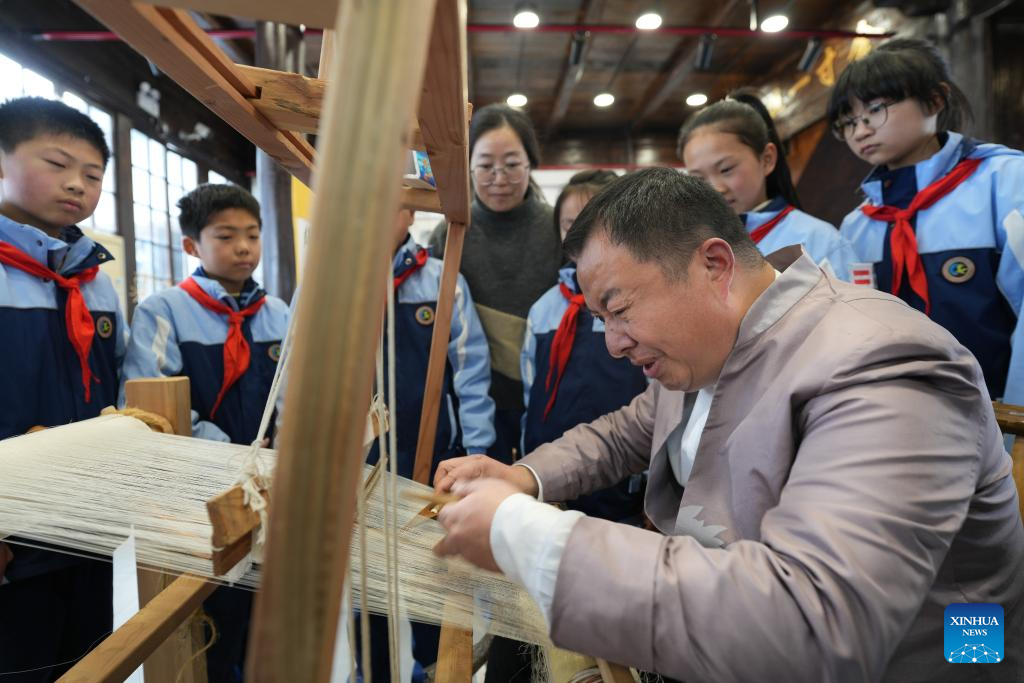
Ke Xiangxiang (front) displays Kesi weaving technique to primary students as their first class in the new semester at his studio in Qianyuan Town of Deqing County, Huzhou City, east China's Zhejiang Province, Feb. 19, 2025. Kesi, one of traditional Chinese silk tapestries, is created by unique silk-weaving method with distinct warp and weft technique.
Ke Xiangxiang is an inheritor of the Kesi weaving technique in Deqing County. He started learning the technique after entering Deqing County arts and crafts factory in 1993. With the revival of the traditional culture, he set up his own intangible cultural heritage studio in 2018. While adhering to the tradition, he has been trying to promote the development of the Kesi weaving technique through innovation. He uses special water ripple patterns to make silk products, such as table cloth, bags, fans and even jewelry, that are more in line with contemporary aesthetics. (Xinhua/Weng Xinyang)
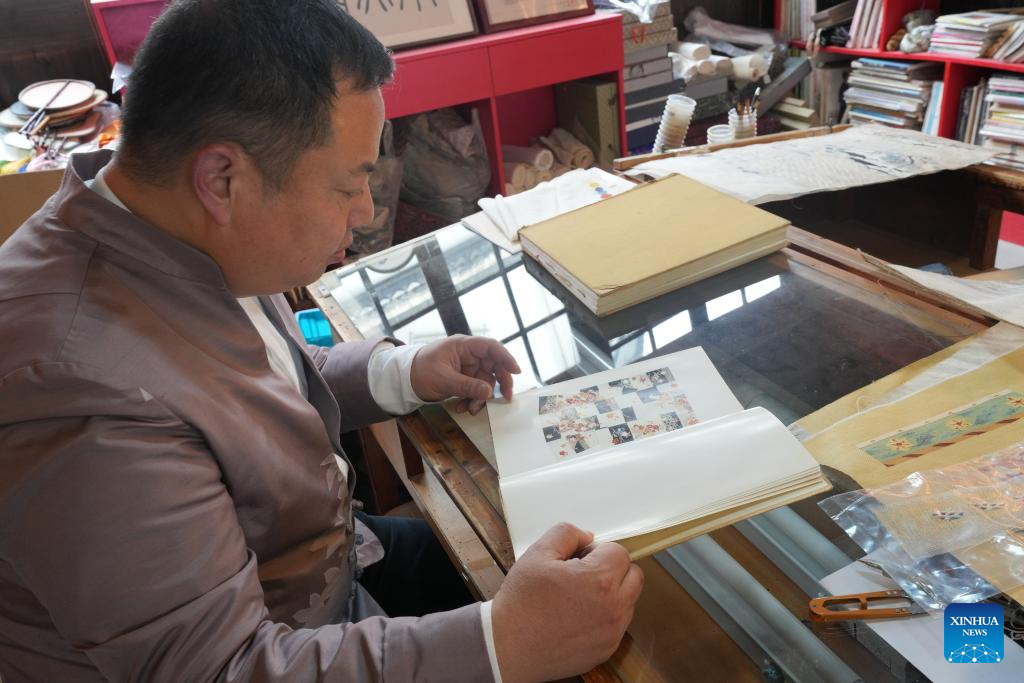
Ke Xiangxiang reads a book for inspiration at his studio in Qianyuan Town of Deqing County, Huzhou City, east China's Zhejiang Province, Feb. 19, 2025. Kesi, one of traditional Chinese silk tapestries, is created by unique silk-weaving method with distinct warp and weft technique.
Ke Xiangxiang is an inheritor of the Kesi weaving technique in Deqing County. He started learning the technique after entering Deqing County arts and crafts factory in 1993. With the revival of the traditional culture, he set up his own intangible cultural heritage studio in 2018. While adhering to the tradition, he has been trying to promote the development of the Kesi weaving technique through innovation. He uses special water ripple patterns to make silk products, such as table cloth, bags, fans and even jewelry, that are more in line with contemporary aesthetics. (Xinhua/Weng Xinyang)







